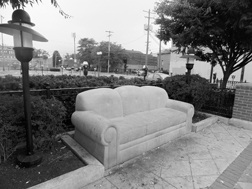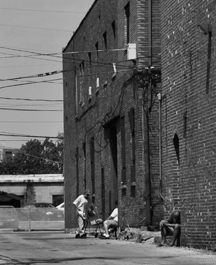
Columbus, Ohio USA
Return to Homepage www.shortnorth.com
Limestone Legacy
Has anything changed since the departure of the grand sofa?
By Tracy Zollinger Turner
September/October 2015 Issue
Return to Homepage • Return to Features Index
Photo © Gus Brunsman III Just over a year ago, the hulking limestone couch sculpture that lived on High Street for ten years was removed. An homage to the Short North’s history as a furniture district, it had been dug into, chipped, tagged with spray paint enough times that it appeared to be rapidly approaching the point of no repair.
It had also become a living and gathering space for homeless people, like a woman known to several locals as “Big Mama,” who took up physical residence on its rock cushions for an extended period of time. Carved from a 20,000-pound block of limestone, the sofa became the locus for reports of public urination, intimidation and petty theft on the sidewalk and in the parking lot behind it.
The official reason the couch was hauled away was to return it to Akron-based artist Robert Huff for restoration, eventually to be reinstalled at the Columbus Cultural Arts Center. It is destined to resurface there later this month.
“I don’t think they had any choice,” Huff says of the decision to remove it. “If it had been small marks, that would have been one thing. But it seemed inevitable that something was going to end up leading to its destruction.”
From the outset, Huff gave the sofa a large enough form to be able to carve it down to remove superficial marks without substantially changing it. He also kept pieces of the original stone in case it needed to be patched.
“When something is in the public domain, vandalism is just a possibility,” he says. “You don’t know what is going to happen. I’ve put extremely delicate things out there that have been left untouched… Sometimes the more indestructible something is, the more of a challenge it becomes to the public.”
While superficial damages were managed over the ten years the couch lived on High Street, there were more severe damages later on, including a deep gouge in one of the arms.
“It seemed as though someone was trying to carve a cup holder or ashtray into it,” says Huff. To repair the sofa, he took the entire surface down about one-eighth of an inch, deepened the crevasses between its cushions and drastically reshaped one of the arms.
“I think it actually looks better now,” he says.
But many who had advocated for the couch’s removal were more concerned about its magnetism as a gathering space than the safety of the artwork. It was the grand dame of a small cluster of public seating, which has, by and large, disappeared from High Street in the Short North. The couch, which was designed to be a bench, albeit not a very comfortable one, had become a public lounge that lived in the geographic center of several churches and public agencies that provide services for the poor, homeless and the mentally disabled, not to mention the plasma donation and check-cashing centers.
Huff, who teaches at the University of Akron, says that he had been told by former students and friends who visited the couch that sometimes people occupying it would demand money of those who wanted to take their picture on it. The limestone, which isn’t particularly comfortable to sit on for long, especially in extreme cold or heat, was sometimes padded with cardboard or newspapers. He was also aware that some local business owners had come to loathe it.
“The last thing in the world that I wanted it to do was create problems for people in the Short North,” he says. But whether the limestone couch was a factor or not, he had heard ironic references to the area squeezed between the gentrifying areas of the lower Short North and south campus as a neighborhood that is ‘trying to get the sofas out of the front yard.’”
Has anything changed since the departure of the sofa?
“The main difference is that the couch isn’t being vandalized anymore,” says Maria Galloway, owner of pm gallery, which sits across the street. “It was an attractive nuisance. It got to the point where something that was supposed to be beautiful started to become an eyesore. People still gather in that area but not as many as used to. It’s not as intimidating to people walking through because they cluster on the parking lot side.”
That clustering is as upsetting as it was when the couch was there to Magnolia Thunderpussy Records and Skully’s Live Music Diner.
An alleyway in the vicinity. © Tracy Zollinger Turner “The stone wall that’s there is three times the size of the sofa,” says Earl “Skully” Webb, who actively lobbied against the sculpture’s presence next to his business. “It took years and years and years to get it removed, but it didn’t take long to realize that it didn’t solve anything.
“People urinate in the flowers, sleep all over the place. Every time you come to work in the morning there are bodies all over the place, passed out from drinking. You can’t wake them up. Whole groups gather in the parking lot. We call the police and they disperse them and they come back an hour later. It’s an hour-by-hour issue. It’s all day every day and it’s been that way for years.”
According to Raad Shubaily, employee of Magnolia Thunderpussy, they routinely call the Short North Ambassadors “anytime the drunks are outside hassling our customers.” At the request of the Short North Alliance, the record store also installed a speaker system to pump classical music into the lot after the couch was removed . A strategy employed by the Port Authority in New York, light rail stations in Oregon and virtually every urban United Dairy Farmers in Columbus, 24-hour classical music is said to lower crime, but there’s not a clear reason why – possibly because it’s soothing and generates a feeling of safety to an area, or possibly because it’s disturbing and discomfiting to those who do not enjoy it.
“The Short North Ambassadors are not police officers and do not have the authority to make arrests, detain individuals, or enforce our laws,” says Betsy Pandora, executive director of the Short North Alliance. “What they have been incredibly effective at doing is helping to get voluntary compliance from individuals who might be breaking the law and preventing more significant crimes from happening by being a constant presence on the street. We always encourage our business owners to call the police in the event that a crime has taken place.”
Webb says that the wall and landscaped shrubbery should be removed and the parking lot expanded to discourage anyone from sleeping or sitting there. According to Pandora, there are no current plans for the site, but the Alliance has seen a reduction of incidents. Between July of 2013 and July of 2014, there were 195 incidents. In the year since the couch was removed, 103 have been reported.
“That is a 47 percent decrease in instances at the site,” she says. “While the primary reason for its removal was for preservation reasons, its removal has certainly made a positive impact to reduce the amount of negative interactions we experience in that area.”
But even as those instances have decreased, homelessness in Franklin County has been sharply rising.
Sara Loken, community relations director of the Community Shelter Board, which is a network of all the shelters “designed to oversee an effective and efficient response system,” says that the current need for shelter “is outstripping the residences available.” The number of single men and women who are homeless in Franklin county has increased 16 percent in the last three years, while the number of homeless families has risen a staggering 79 percent. Over 10,000 people were served in shelters last year.
Families are not turned away according to policy, sometimes leaving organizers scrambling for room in church basements and motels. After adding 100 shelter beds in the last year, there are still waiting lists.
“There will always be people who are homeless. There are people who are homeless all over this city. This is not unique to the Short North,” says Pastor Jennifer Casto of the New Life United Methodist Church, which sits on Fifth Avenue just off of High, along the alleyway that connects to the parking lot. The church serves free breakfasts two mornings a week, provides free basic health care services one morning a week, has a free clothing room and provides space for multiple Narcotics and Alcoholics Anonymous meetings per week.
“We have all of the same problems that anyone in the neighborhood has, finding people on our property, doing things that they are not supposed to. I am as frustrated as business owners are,” she says. “I have a relationship with the people who are hanging around the building. I’ll just say ‘you need to get up and clean up your mess.’ People leave all kinds of messes on our property. We have a policy that nobody sleeps on the church property for their safety and the safety of the church, but I’ve been told by some who have that they felt it was the safest place they’ve ever slept.”
Sleeping in public is not illegal in Columbus. According to an August statement of interest by the U.S. Department of Justice, cities like Boise, Idaho, where city ordinances called for the arrest of people who sleep or camp in public spaces, such enforcement “criminalizes the status of being homeless,” especially when shelters are full, and violates the Eighth Amendment. In Columbus, law enforcement typically ask people to move unless they are clearly in need of some kind of care.
The relandscaped section where the sofa was removed, seen from the parking lot. © Tracy Zollinger Turner Galloway says she has had many people sleep in the doorway of her business and often looked at them more like protective sentries.
“As long as they don’t leave a mess, I don’t mind. It can even protect the business. One of the physical problems homeless people have is that blood pools in their lower extremities and they get ulcers if they don’t have a place to lie down,” says Galloway, noting that she feels public bathrooms would be a welcome, compassionate addition to the neighborhood. “It’s easier to find a place for a dog to go the bathroom than a homeless person.”
Since first opening her gallery in the Short North in 1980, Galloway has seen the homeless population shift, and she says that what she sees in the parking lot goes beyond people without shelter.
“The homeless, or homelessness, is one issue,” she says. “The mentally ill that have no place to live is another. The government has really failed us and been failing us for decades. Many of the people who gather in that lot are unable to follow the rules at homeless shelters. A lot of them are living in the parks. We call them the screamers.”
The legacy, she says, goes back to the early 1980s, when many federally funded asylums were shut down and their severely mentally disabled patients were cast out into communities with little or no net.
“All of a sudden we started seeing these people on the street that hadn’t seen the sun in a long time,” she says. “They looked like ghosts. Some of them were functional and some weren’t. Some would argue with themselves in the windows.”
She’s made calls to the police or Netcare when she’s witnessed someone, possibly having stopped medications, in the middle of the street or otherwise becoming a danger to themselves or others.
“It all gets so complicated so fast. I observe, and go ‘man, that’s not right.’
I don’t have solutions but I have hopes,” she says. “These people do not deserve to live like this. No one does.”
The Garden Church, which did not return phone calls, has long had a contentious image in the neighborhood because of the population it serves.
Webb, of Skully’s, is critical of the nearby churches.
“All these bleeding hearts… They’re not helping them. They’re just feeding them and making them someone else’s problem. It’s one thing to take care of people, it’s another to feed people and then leave all the problems to the neighborhood,” he says. “These are bums, drunks, vagrants, thieves, vandals, liars that break into cars if they see a quarter on the dash.”
Car break-ins and other negative experiences of the parking lot often end up on Yelp reviews for Skully’s Music Diner, which, Webb says, is perceived as owning the city lot.
According to Casto, “these people are human beings, they are neighbors, they are people who are part of our church community. They are people of infinite worth who have the potential to be sober and strong and have a fulfilling life. You can’t just write off the folks we are talking about.”
Loken of the Community Shelter Board says that there are aggressive new initiatives to open more shelters, create more housing and try to close the gap. New resources at the Maryhaven treatment center include set-aside beds for people who are publically intoxicated or possibly unable to deal with the rules of a shelter due to a mental disability. There is also an outreach team that “goes out and looks for people staying outdoors, are able to engage people and ask them to come into shelter or subsidized housing for people with disabilities. And they are able to do that with 90 percent of the people they serve.”
“Alcohol is an easy cheap thing to get a hold of and a way to numb the pain of homelessness,” says Casto of New Life. “But I’ve also seen a lot of people get into programs, get into meetings and get out of homelessness. I won’t take credit for it, but those people have come to our church and found people who believe they can be something more than ‘the homeless who are causing a problem in our community.’”There is a central phone number for homeless single adults in Central Ohio, 1-888-4SHELTR (1-888-474-3587). “A compassionate person who has seen someone sleeping in their community repeatedly could let them borrow their phone to make this call,” says Loken of the Community Shelter Board. Alternatively, those who repeatedly witness someone who appears to be homeless and mentally disabled can “call on the team at Maryhaven and say ‘I keep seeing this person in need,’ and let them know the location. That number is (614) 449-1530.
© 2015 Short North Gazette, Columbus, Ohio. All rights reserved.
This article was reported with support from Puffin Foundation West., Ltd. Return to Homepage www.shortnorth.com



